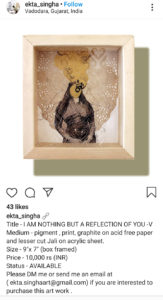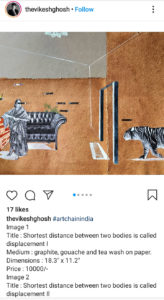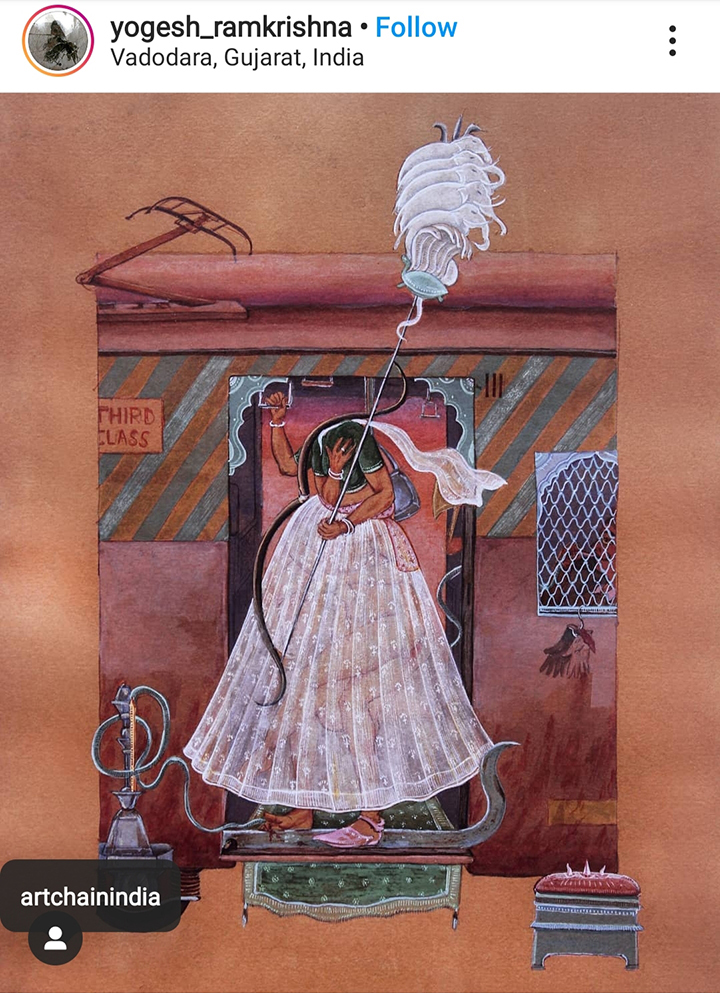At a time when artists need support badly due to the lockdown, a unique community initiative on Instagram is keeping hopes high and generating some income
With rampant pay cuts and layoffs becoming the norm, people are finding it increasingly difficult to support themselves. The scene is no different in the field of arts, especially for those who are just starting out.
Fearing that this might lead to artists exiting their current practice, and dissatisfied with the limited financial support provided, two Delhi-based artists took matters into their own hands.
Artist Purvai Rai and Ayesha Singh’s brainchild #ArtChainIndia is an initiative that helps artists showcase their work and connects them directly to viewers and prospective buyers. What makes it even better is that it is all affordable.
Using Instagram as a platform, the initiative is a peer support movement, wherein artists support artists.
Simply structured, artist can upload their work with the hashtag, keeping in mind that the selling price ranges between Rs 500 and Rs 10,000. Each work is uploaded with the pledge that once the artist makes Rs 50,000 from sales, he/she will buy another artist’s work for Rs 10,000, continuing the chain.

During the previous stages of the lockdown, Rai and Singh waited to see how government and institutional support would reach out and help artists. “While a lot of private institutions are giving grants at some point, we realised that is very limited,” says Singh.
The initial plan, prior to lockdown, was to create a community space for young artists to come together, have conversations and share their queries. With the onset of the pandemic, they decided to address the more pressing issue of financial stability.
So what propelled them to start this initiative? By way of answer, Rai and Singh take us back to the days when they had started out in their careers.
“When I came back to the country after completing my undergraduation abroad, I didn’t know where to begin and how to reach out to other creative people in the city,” recalls Singh. This led to the creation of The Creative Community. The idea was to create an environment where young artists could have a conversation about their ideas and have the potential for collaboration.
The project died down when she left for her Master’s. On her return, she decided to address this problem again and floated an idea of a community space on Instagram, where Rai got in touch.

Rai shares that her interest in a community structure started while creating a photography magazine in 2015. “Running the magazine, I was in conversation with the various stakeholders of the creative and cultural industry. A lot of queries came from artists.”
Putting the spotlight on the struggles faced by art students when they graduate, Rai points to the gap between education and practice. “It’s just not about creating, once you develop your style there is that little gap that needs to be addressed to move ahead in the practice. Art Chain looks at how you can fill that gap.”
While the idea was to bring about such a community structure, it was halted due to Covid-19. They instead decided to come to the financial aid of young artists.
One of their main concerns was that a pandemic like this would perhaps lead to people changing their career paths. “When everyone is talking about how the art market is going down, how is it going to survive, artists end up looking for other options at this point of time if they cannot support themselves,” says Singh.

“Anyway there is a lot of stigma about how one can make a living if you are in the creative field, and this pandemic feeds that stigma,” Rai adds. Hence, the intention of this project was to reach the people who rely on this practice.
Calling this a “democratic movement”, Singh shares that they are not here as promoters. There is no gallery involvement, no commission and no curation. This makes it a lot more accessible and friendly for many who otherwise keep away from the art market. “It’s a space where buyers can also develop their taste since there is an array of work of different disciplines and practices.”
Unlike other curated shows, there is no one to approve or select the works here, as against the norms in the field. With no such criteria, as long as you are a practising artist, you can participate.
“For an artist who may have never sold or is looking out to sell, they get a chance to engage with the buyers. When there is no curation involved, artists become more confident and independent about their work, because they have to now decide what their best work is,” says Rai.
Over 120 works have been sold over the past three weeks, since inception. Around 3,200 artworks have been uploaded with the hashtag till date and the movement is slowly gaining momentum.

“We are looking forward to demystifying the art scene and creating intergenerational conversations and building an education platform. We have a larger intention with this, but monetary stability was the need of the moment. From here on it will expand more,” they conclude.





